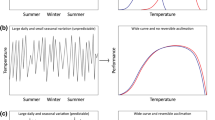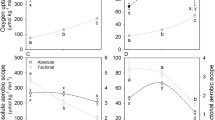Abstract
The strategies used by ectotherms to minimise the detrimental effects of suboptimal thermal environments on physiological performance are often related to whether they inhabit a terrestrial or aquatic environment. Most terrestrial ectotherms use thermoregulatory strategies to maintain body temperature within an optimal range, while many aquatic ectotherms utilise thermal acclimation to maintain performance over varying seasonal temperatures. This study aimed to elucidate the relative contributions of acclimation and behavioural thermoregulation to maintaining whole-animal performance over varying seasonal temperatures in the semi-terrestrial Lamington spiny crayfish (Euastacus sulcatus). Crayfish activity and surface temperatures were determined by means of radio tracking and behavioural observations. Field studies demonstrated that E. sulcatus is exposed to stable daily temperatures, varying only between seasons from 10°C in late winter to over 20°C in summer. Also, terrestrial behaviour corresponded to a small portion of crayfish time (1.13%), much lower than predicted, indicating that E. sulcatus has limited opportunity for behavioural thermoregulation. We also tested the effect of acclimation to either 10 or 20°C on chela strength and stamina. We found acclimation had a more marked effect on chela stamina than maximum strength measures; however, overall acclimatory capacity was limited in E. sulcatus. Thus, we found that the semi-terrestrial crayfish E. sulcatus used neither thermoregulatory behaviours nor physiological strategies to deal with seasonal changes in environmental temperature.






Similar content being viewed by others
References
Angilletta MJ, Niewiarowski PH, Navas CA (2002) The evolution of thermal physiology in ectotherms. J Therm Biol 27:249–268
Angilletta MJ Jr, Bennett AF, Guderley H, Navas CA, Seebacher F, Wilson RS (2006) Coadaptation: a unifying principle in evolutionary thermal biology. Physiol Biochem Zool 79:282–294
Beddow TA, Vanleeuwen JL, Johnston IA (1995) Swimming kinematics of fast starts are altered by temperature acclimation in the marine fish Myoxocephalus scorpius. J Exp Biol 198:203–208
Bennett AF (1990) Thermal dependence of locomotor capacity. Am J Physiol 259:R253–R258
Bennett AF, Huey RB (1990) Studying the evolution of physiological performance. In: Futuyma D, Antonovics J (eds) Oxford surveys in evolutionary biology. Oxford University Press, New York
Bovbjerg RV (1953) Dominance order in the crayfish, Orconectes virilis (Hagen). Physiol Zool 26:173–178
Bovbjerg RV (1956) Some factors affecting aggressive behaviour in crayfish. Physiol Zool 29:127–136
Boyer DR (1965) Ecology of the basking habit in turtles. Ecology 46:99–118
Bubb DH, Lucas MC, Thom TJ (2002) Winter movements and activity of signal crayfish Pacifastacus leniusculus in an upland river, determined by radio telemetry. Hydrobiologia 483:111–119
Bywater C, Angilletta MJ, Wilson RS (2008) Weapon size is a reliable predictor of weapon strength and social dominance in females of the slender crayfish. Funct Ecol 22:311–316
Crawshaw LI (1983) Effects of thermal acclimation and starvation on temperature selection and activity in the crayfish, Orconectes immunis. Comp Biochem Physiol A 74:475–477
Else PL, Bennett AF (1987) The thermal dependence of locomotor performance and muscle contractile function in the salamander Ambystoma tigrinum nebulosum. J Exp Biol 128:219–233
Espina S, Diaz Herrera F, Buckle RLF (1993) Preferred and avoided temperatures in the crawfish Procambarus clarkii (Decapoda, Cambaridae). J Therm Biol 18:35–39
Furse JM, Wild CH (2004a) Instream and terrestrial movement of Euastacus sulcatus in the Gold Coast hinterland: developing and testing a method of accessing freshwater crayfish movements. Freshw Crayfish 14:212–220
Furse JM, Wild CH (2004b) Laboratory moult increment, frequency and growth in Euastacus sulcatus, the Lamington spiny crayfish. Freshw Crayfish 14:205–211
Gabbanini F, Gherardi F, Vannini M (1995) Force and dominance in the agonistic behavior of the freshwater crab Potamon fluviatile. Aggress Behav 21:451–462
Gabriel W (1999) Evolution of reversible plastic responses: inducible defenses and environmental tolerance. In: Harvell CD, Tollrian R (eds) The ecology and evolution of inducible defenses. Princeton University Press, Princeton, pp 286–305
Gabriel W (2005) How stress selects for reversible phenotypic plasticity. J Evol Biol 18:873–883
Glanville EJ, Seebacher F (2006) Compensation for environmental change by complementary shifts of thermal sensitivity and thermoregulatory behaviour in an ectotherm. J Exp Biol 209:4869–4877
Hammill E, Wilson RS, Johnston IA (2004) Sustained swimming performance and muscle structure are altered by thermal acclimation in male mosquitofish. J Therm Biol 29:251–257
Huey RB, Berrigan DA (2001) Temperature, demography, and ectotherm fitness. Am Nat 158:204–210
Huey RB, Berrigan D, Gilchrist GW, Herron JC (1999) Testing the adaptive significance of acclimation: a strong inference approach. Am Zool 39:323–336
Johnson TP, Bennett AF (1995) The thermal acclimation of burst escape performance in fish: an integrated study of molecular and cellular physiology and organismal performance. J Exp Biol 198:2165–2175
Johnston IA, Bennett AF (1996) Animals and temperature: phenotypic and evolutionary adaptation. Cambridge University Press, New York
Johnston K, Robson BJ (2009) Habitat use by five sympatric Australian freshwater crayfish species (Parastacidae). Freshw Biol 54:1629–1641
Morgan GJ (1991) The spiny freshwater crayfish of Queensland. Qld Nat 31:29–36
Morgan GJ (1997) Freshwater crayfish of the genus Euastacus Clark (Decapoda: Parastacidae) from New South Whales, with a key to all species of the genus. Rec Aust Mus Suppl 23:1–110
Morris S (2005) Respiratory and acid-base responses during migration and to exercise by the terrestrial crab Discoplax (cardisoma) hirtipes, with regard to season, humidity and behaviour. J Exp Biol 208:4333–4343
O’Steen S, Bennett AF (2003) Thermal acclimation effects differ between voluntary, maximum, and critical swimming velocities in two cyprinid fishes. Physiol Biochem Zool 76:484–496
Ponniah M, Hughes JM (2004) The evolution of Queensland spiny mountain crayfish of the genus Euastacus. I. Testing vicariance and dispersal with interspecific mitochondrial DNA. Evolution 58:1073–1085
Riek EF (1951) The freshwater crayfish (Family Parastacidae) of Queensland. Records of the Australian Museum 22:368–388
Schauble CS, Grigg GC (1998) Thermal ecology of the Australian agamid Pogona barbata. Oecologia 114:461–470
Seebacher F (2009) Responses to temperature variation: integration of thermoregulation and metabolism in vertebrates. J Exp Biol 212:2885–2891
Seebacher F, Grigg GC (2001) Changes in heart rate are important for thermoregulation in the varanid lizard Varanus varius. J Comp Physiol B Biochem Syst Environ Physiol 171:395–400
Seebacher F, Wilson RS (2006) Fighting fit: thermal plasticity of metabolic function and fighting success in the crayfish Cherax destructor. Funct Ecol 20:1045–1053
Seebacher F, Wilson RS (2007) Individual recognition in crayfish (Cherax dispar): the roles of strength and experience in deciding aggressive encounters. Biol Lett 3:471–474
Sneddon LU, Huntingford FA, Taylor AC, Orr JF (2000) Weapon strength and competitive success in the fights of shore crabs (Carcinus maenas). J Zool 250:397–403
Wilson RS, Franklin CE (1999) Thermal acclimation of locomotor performance in tadpoles of the frog Limnodynastes peronii. J Comp Physiol B 169:445–451
Wilson RS, Franklin CE (2000) Inability of adult Limnodynastes peronii (Amphibia: Anura) to thermally acclimate locomotor performance. Comp Biochem Physiol A 127:21–28
Wilson RS, Franklin CE (2002) Testing the beneficial acclimation hypothesis. Trends Ecol Evol 17:66–70
Wilson RS, James RS, Johnston IA (2000) Thermal acclimation of locomotor performance in tadpoles and adults of the aquatic frog Xenopus laevis. J Comp Physiol B 170:117–124
Wilson RS, Angilletta MJ, James RS, Navas C, Seebacher F (2007a) Dishonest signals of strength in male slender crayfish (Cherax dispar) during agonistic interactions. Am Nat 170:284–291
Wilson RS, Hammill E, Johnston IA (2007b) Competition moderates the benefits of thermal acclimation to reproductive performance in male eastern mosquitofish. Proc R Soc Lond Ser B 274:1199–1204
Wood CM, Boutilier RG, Randall DJ (1986) The physiology of dehydration stress in the land crab, Cardisoma carnifex: respiration, ionoregulation, acid–base balance and nitrogenous waste excretion. J Exp Biol 126:271–296
Acknowledgments
We thank Peter Kennedy for allowing us to utilise his property for tracking and collection of crayfish. We also thank the many volunteers that assisted with field work and Stewart Macdonald for generously giving time and effort into this project.
Author information
Authors and Affiliations
Corresponding author
Additional information
Communicated by I. D. Hume.
Rights and permissions
About this article
Cite this article
Lowe, K., FitzGibbon, S., Seebacher, F. et al. Physiological and behavioural responses to seasonal changes in environmental temperature in the Australian spiny crayfish Euastacus sulcatus . J Comp Physiol B 180, 653–660 (2010). https://doi.org/10.1007/s00360-010-0445-2
Received:
Revised:
Accepted:
Published:
Issue Date:
DOI: https://doi.org/10.1007/s00360-010-0445-2




